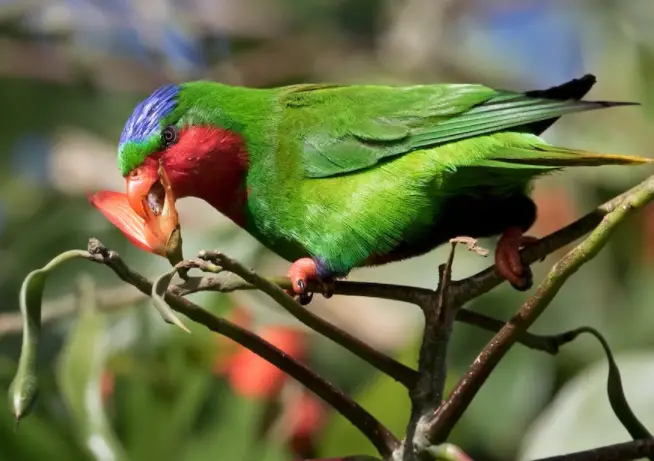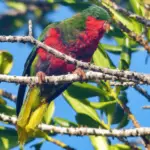
Blue-crowned Lorikeet 19 cm; 47–52 g. Orange bill, grass-green forehead backed by pale bright purplish-blue mid-to
the hind crown with slightly elongate feathers; patch from lores and below the eye to upper breast red;
rest of body green except for a red belly patch that shades purple between and onto thighs, the underside of tail yellowish, legs orange. Immature has less color on the undersides.
Monotypic.
Subspecies
Monotypic.
Distribution
Wallis and Futuna Are, E Fiji (S Lau Archipelago), Samoa, American Samoa, Tonga, and Niue.
Habitat
Forest, scrub, gardens and plantations, wherever flowering trees are present; commoner or more easily detected in cultivated areas than in the forest, but much rarer in the cleared forest or urban land.
Movement

Blue-crowned Lorikeets are highly mobile, moving about within islands in search of foods as they become available, and apparently a well-known inter-island nomad.
Diet and Foraging
Blue-crowned Lorikeet feeding Nectar, pollen, and soft fruit, with a preference for coconut, mango, Erythrina, Elaeocarpus angustifolius, and Calophyllum inophyllum.
However, on Niuafo’ou flowering Casuarina is a key food source, others being Sterculia fanaiho, Kleinhovia hospital, Musa paradisiaca, Alphitonia ziziphoides, Pueraria lobata, Barringtonia Asiatica, Hibiscus tiliaceus, and Pometia pinnata; elsewhere flowers of thatching palm Metroxylon noted.

The use of unripe mangoes and flowers of a woody weed Stachyrtarpheta urticifolia was probably the result of a food shortage following a hurricane.

Sounds and Vocal Behavior
The commonest vocalization is a rather pure, high-pitched whistle, “seee!”, drawn-out and either even-pitched or upslurred, given both in flight and when perched. Also somewhat more complex, squeaky high-pitched notes.
Breeding
Possibly throughout the year as records are for Mar, Jun, Aug & Dec (nestlings). Blue-crowned Lorikeet Nest a hole in a tree, once a Hibiscus; records of using holes in earth banks probably involved takeovers of old kingfisher nests. Eggs 1–2; incubated in captivity for 23 days.
LORI FRINGILLAIRE – BLUE-CROWNED LORIKEET – VINI AUSTRALIS
SOURCE:LES OISEAUX DU FAUCIGNY
Conservation Status

Not globally threatened. CITES II. A BirdLife “restricted-range” species. Common throughout much of the range, including Lau Archipelago, Samoa, and Futuna, with numbers estimated between several 100s and several 1000s; but on Wallis, extinct for unknown reasons, though probably due to black rats (Rattus rattus).
Declining in Tonga, but abundant on Niuafo’ou (several thousand pairs) and, by 1974 report, Niuatoputapu, while uncommon on Late, probably owing to the scarcity of flowering trees. A population of around 60 survives on ‘Eue’iki in the Tongatapu group, 1990, were isolated for probably 100 years.
The extinction of the species on ‘Eua occurred within 50 years of the island’s colonization by R. Rattus. The steady spread of the Jungle Myna (Acridotheres fuscus) through the Fijian, Tongan and Samoan archipelagos is viewed with concern, given its aggressive ability to compete for nest holes.
SOURCE:obirds




















